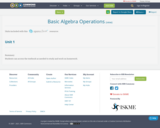
Students can access the textbook as needed to study and work on homework.
- Subject:
- Algebra
- Mathematics
- Material Type:
- Textbook
- Date Added:
- 09/25/2019
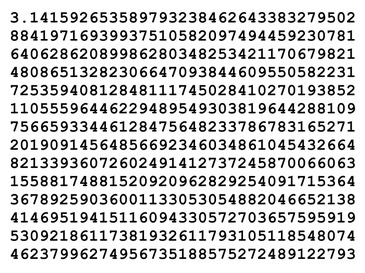
Algebra, Calculus, Functions, Geometry, Numbers and Operations, Measurement and Data, Ratios and Proportions, Statistics and Probability, Trigonometry.

Students can access the textbook as needed to study and work on homework.
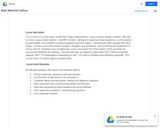
This course is a continuation of MAT087, Basic Mathematics. Topics include signed numbers, decimal numbers, exponential notation, scientific notation, solving and graphing linear equations, an introduction to polynomials, and systems of linear equations and their graphs. Geometrical topics include lines and angles, closed curves and convex polygons, triangles and similarities, and symmetry and proportion in nature and art. Students may complete this course during the first three weeks of the semester by passing the MyMathLab modules. Students will then be eligible to take either MAT 099 Intermediate Algebra, MAT 114-Quantitative Reasoning or MAT 120-Intro to Statistics the following semester. This course does not satisfy degree requirements.
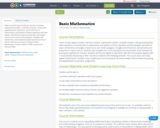
Topics include signed numbers, decimal numbers, exponential notation, scientific notation, solving and graphing linear equations, an introduction to polynomials, and systems of linear equations and their graphs. Geometrical topics include lines and angles, closed curves and convex polygons, triangles and similarities, and symmetry and proportion in nature and art. All course content by Valerie Dietel-Brenneman. Content added to OER Commons by Victoria Vidal.

Topics include signed numbers, decimal numbers, exponential notation, scientific notation, solving and graphing linear equations, an introduction to polynomials, and systems of linear equations and their graphs. Geometrical topics include lines and angles, closed curves and convex polygons, triangles and similarities, and symmetry and proportion in nature and art. Students may complete this course during the first three weeks of the semester by passing the MyMathLab modules. Students will then be eligible to take either MAT 099 Intermediate Algebra, MAT 114-Quantitative Reasoning or MAT 120-Intro to Statistics the following semester. This course does not satisfy degree requirements. Students may complete this course during the first three weeks of the semester by passing the MyOpenMath Acceleration assignments.
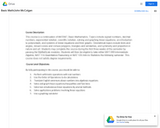
This course is a continuation of MAT087, Basic Mathematics. Topics include signed numbers, decimal numbers, exponential notation, scientific notation, solving and graphing linear equations, an introduction to polynomials, and systems of linear equations and their graphs. Geometrical topics include lines and angles, closed curves and convex polygons, triangles and similarities, and symmetry and proportion in nature and art. Students may complete this course during the first three weeks of the semester by passing the MyMathLab modules. Students will then be eligible to take either MAT 099 Intermediate Algebra, MAT 114-Quantitative Reasoning or MAT 120-Intro to Statistics the following semester. This course does not satisfy degree requirements.
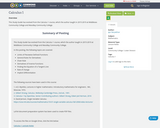
This Study Guide has evolved from the Calculus 1 course, which the author taught in 2015-2019 at Middlesex Community College and MassBay Community College.
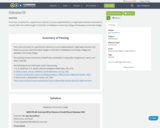
This is the curriculum for a asynhronous Calculus III course implemented for an eight-week semester and based on courses, which the author taught in 2016-2021 at Middlesex Community College and MassBay Community College.
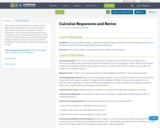
This course is a brief introduction to sequences and infinite series. We begin with a discussion of power series and develop tests for convergence and non-convergence. Taylor series are introduced and lead to an analysis of power series in general. This is a 1-credit course that can be taken any time after the student has completed Calculus I. All course content created by Javad Moulai. Content added to OER Commons by Julia Greider.
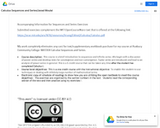
This course is a brief introduction to sequences and infinite series. We begin with a discussion of power series and develop tests for convergence and non-convergence. Taylor series are introduced and lead to an analysis of power series in general. This is a 1-credit course that can be taken any time after the student has completed Calculus I.
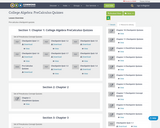
Pre-calculus problem sets and quizzes.CC x BY Lauren Brewer
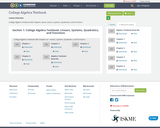
College Algebra Textbook with chapters about Linears, Systems, Quadratics, and FunctionsCC x BY Ben Atchison
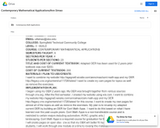
Full course on Contemporary Mathematical Applications.
![Course Lecture Slides : ROTEL Project Statistics Through an Equity Lens [Revised Edition].](https://img.oercommons.org/160x134/oercommons/media/courseware/lesson/image/Cover_RotelProject_FrSU-Statistics-Anthony-RE.jpg)
These are course lecture slides that are a companion for teaching ROTEL Project Statistics Through an Equity Lens [Revised Edition]. Statistics Through an Equity Lens [Revised Edition] carries a significant responsibility by presenting statistics through an equity lens. There are 8 chapters in Statistics Through an Equity Lens [Revised Edition]. Chapters 7 and 8 are Case Studies and Hypothesis Testing. This Ancillary Resource is Course Lecture Slides for Chapters 1-6. A brief outline of the chapters’ contents follows by section.
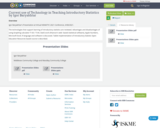
Igor Baryakhtar's Presentation at Virtual NEMATYC 2021 Conference, 4/08/2021.The technologies that support learning of introductory statistics are reviewed. Advantages and disadvantages of using Graphing calculator TI 83 / TI 84, StatCrunch (Pearson's web- based statistical software), Apple Numbers, Microsoft Excel, R language and software is discussed. Tablet implementation of Introductory Statistic Open Education Resources based course is described.

Introductory Statistics Course covering hypothesis testing, confidence interval, sampling, probability, counting techniques, correlation, linear regression, data collection and more.
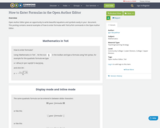
Open Author Editor gives an opportunity to write beautiful equations and symbols easily in your document.This posting contains several examples of how to enter formulas with TeX/LaTeX commands in the Open Author Editor.
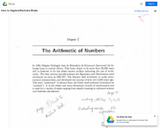
Introductory Algebra is the second of three classes in the developmental mathematics sequence. It provides a development of concepts of variables, expressions, and equations using symbolic algebra to represent primarily linear relationships both graphically and analytically. The concept of function will be developed for the application of linear equations and concepts of dependent and independent variable. Students will also learn to solve simultaneous linear equations as well as how to construct linear equations from slope and point information. Application problems will include geometric figure quantities, ratio and proportion, direct and indirect variation, and conversion of units. Finding the greatest common factor of a polynomial will also be included. The emphasis of the three semester sequence is fortification of mental calculation power with minimum reliance on digital calculation.
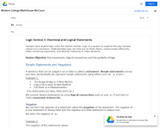
Survey course for college mathematics.

The New England Mathematical Association of Two Year Colleges 2021 Virtual Conference.
(Monday, April 5 - Friday, April 16)
Recorded presentations

This OER course using a new textbook is based a section of MAT103 Pre-Calculus. It is a preparatory course for Calculus. It builds upon the intermediate level of Algebra and makes intensive use of technology to conceptualize functions and methods of function manipulation with emphasis on quantitative change. All course content written by Fahmil Shah. Added to OER Commons by Victoria Vidal.